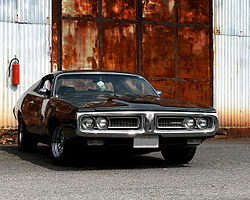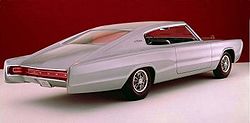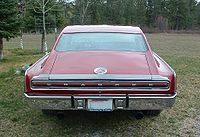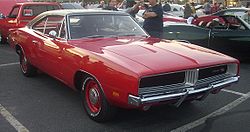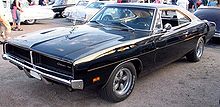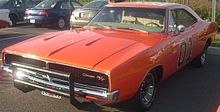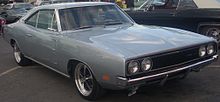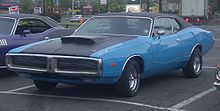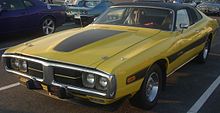- Dodge Charger (B-body)
-
For the full series, see Dodge Charger.
Dodge Charger Manufacturer Chrysler Corporation Production 1966–1978 Successor Dodge Magnum Class Mid-size Body style 2-door coupe Layout FR layout Platform B-body The Dodge Charger was a mid-size automobile produced by Dodge. The 1966-1974 Chargers were based on the Chrysler B platform. The 1975-1978 Chargers were based on the Chrysler Cordoba.
Contents
Origin of the Charger
In the early sixties many were exploring new ideas in the personal luxury and specialty car segments. Chrysler, slow to enter the specialty car market, selected their Dodge Division to enter an untapped market for a bigger model to fit between the "pony car" Ford Mustang and the "personal luxury" Ford Thunderbird.[1] The intention was to use the B-body for a sporty car with fastback look while sharing as much of their existing hardware as possible.[1]
Burt Bouwkamp, Chief Engineer for Dodge during the 1960s and one of the men behind the Dodge Charger, related his experience during a speech in July 2004.
- Lynn Townsend was at odds with the Dodge Dealers and wanted to do something to please them. So in 1965 he asked me to come to his office - for the second time. He noted that one of the Dodge Dealer Council requests was for a Barracuda type vehicle. The overall dealer product recommendation theme was the same - we want what Plymouth has. The specific request for a Mustang type vehicle was not as controversial to Lynn. His direction to me was to give them a specialty car but he said 'for God's sake don't make it a derivative of the Barracuda': i.e. don't make it a Barracuda competitor.
- So the 1966 Charger was born.
- "We built a Charger 'idea' car which we displayed at auto shows in 1965 to stimulate market interest in the concept. It was the approved design but we told the press and auto show attendees that it was just an "idea" and that we would build it if they liked it. It was pre-ordained that they would like it."[2]
1966–1967
The 1966 and 1967 Dodge Chargers were all fastback vehicles. They shared a chassis and front-end sheet-metal with their mid-sized Dodge Coronet brethren. These first two years of the Dodge Charger are also the only two models which displayed the Fratzog Emblem on the grill as well as the trunk hatch.
1966
First generation 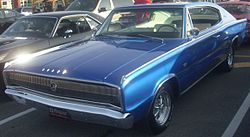
Production 1966–1967 Assembly United States: Detroit, Michigan (1966)
Hamtramck, Michigan (1967)Engine 318 cu in (5.2 L) 2bbl A V8 (1966)
318 cu in (5.2 L) 2bbl LA V8 (1967)
361 cu in (5.9 L) 2bbl B V8 (1966)
383 cu in (6.3 L) 2bbl B V8 (1967)
383 cu in (6.3 L) 4bbl B V8
426 cu in (7.0 L) 2x4bbl Hemi RB V8
440 cu in (7.2 L) 4bbl RB V8 (1967)Transmission A230 3-speed manual
A833 4-speed manual
TorqueFlite 3-speed automaticWheelbase 117.0 in (2,970 mm) Length 203.6 in (5,170 mm) Width 75.8 in (1,930 mm) Related Dodge Coronet
Plymouth Belvedere
Plymouth Satellite
Plymouth GTXOn January 1, 1966, viewers of the Rose Bowl were first introduced to the new "Leader of the Dodge Rebellion", the 1966 Charger. The Charger's debut also followed by a half model year the introduction of a new street version of the 426 cu in (7.0 L) Chrysler Hemi engine. With the Charger, Dodge had a new model to build a performance image to go along with this engine.
Designed by Carl "CAM" Cameron, the Dodge Charger introduced a fastback roofline and a pot-metal "electric shaver" grille. The grille used fully rotating headlights (180 degree) that when opened or closed made the grille look like one-piece unit. Hidden headlamps were a feature not seen on a Chrysler product since the 1942 DeSoto. In the rear of the new Dodge, the fastback design ended over a full-width six-lamp taillight that featured chromed "CHARGER" lettering.
Inside, the standard Charger featured a simulated wood-grain steering wheel, four individual bucket seats with a full length console from front to rear. The rear seats and rear center armrest pad also folded forward while the trunk divider dropped back, which allowed for generous cargo room.[3] Numerous interior features were exclusive to the Charger including door panels, courtesy lights, as well as premium trim and vinyl upholstery. The instrument panel did not use regular bulbs to light the gauges, but rather electroluminescence lit the four chrome-ringed circular dash pods, needles, radio, shifter-position indicator in the console, as well as clock and Air Conditioning controls if equipped. The dash housed a 0 to 6000 rpm tachometer, a 0 to 150 mph (240 km/h) speedometer, as well as alternator, fuel, and temperature gauges as standard equipment.[3]
Engine selections consisted of only V8s, though a straight-six engine engine became standard by 1968. 1966 transmissions included a three-speed steering-wheel mounted manual with only the base engine, a console mounted four-speed manual or three-speed automatic. In 1966, four engines were offered: the base-model 318 cu in (5.2 L) 2-barrel, the 361 cu in (5.9 L) 2-barrel, the 383 cu in (6.3 L) 4-barrel, and the new 426 Street Hemi. Only 468 Chargers were built with the 426.[4]
Total production in 1966 came to 37,344 units for the mid-model year introduction.
In 1966 Dodge took the Charger into NASCAR in hopes that the fastback would make their car a winner on the high-banks. But the car proved to have rear end lift around corners which made it very slippery on the faster tracks. The lift was because the air actually traveled faster over the top of the car than under it, causing the car to act like a giant airplane wing. Drivers would later claim that "it was like driving on ice." In order to solve this problem Dodge installed a small lip spoiler on the trunk lid which improved traction at speeds above 150 mph (240 km/h). They also had to make it a dealer-installed option in late 1966 and 1967 because of NASCAR rules (with small quarter panel extensions in 1967). The 1966 Charger was the first U.S. production vehicle to offer a spoiler. David Pearson, driving a #6 Cotten Owens-prepared Charger, went on to win the NASCAR Grand National championship in 1966 with 14 first-place finishes.
1967
The 1967 model year Charger received minor changes. Outside, new fender-mounted turn signals were introduced and this would serve as the main external identifier between a 1966 and 1967 Charger. A vinyl roof become available. Inside, the full length console was gone, due in part to customer complaints about entry and exit from the back seats. It was replaced with a regular sized console. Bucket seats were standard, but a folding armrest/seat and column shifter was an option allowing three people to sit up front.
The 440 "Magnum" was added and the 361 cu in (5.9 L) V8 was replaced by a 383 cu in (6.3 L) engine. The 440 was rated at 375 hp (280 kW) with a single 4-barrel carburetor. The 318 two-barrel "LA" Chrysler LA engine was now the base engine with wedge-shaped combustion chambers, unlike the previous 1966 polyspherical (or "poly") design. The 383 4-barrel and the 426 Street Hemi remained as options. A mere 117 Chargers were built with the 426 engine.
Sales of the 1967 Chargers dropped to half of the previous introductory half-year with a total of 15,788 units.[5]
1968–1970
1968
Second generation Production 1968–1970 Assembly United States: Detroit, Michigan
Hamtramck, Michigan
Los Angeles, California
St. Louis, MissouriEngine 225 cu in (3.7 L) 1bbl I6 (1969-70)
318 cu in (5.2 L) 2bbl LA V8
383 cu in (6.3 L) 2bbl B V8
383 cu in (6.3 L) 4bbl B V8
426 cu in (7.0 L) Hemi 2x4bbl RB V8
440 cu in (7.2 L) 4bbl RB V8
440 cu in (7.2 L) 2x3 RB (1970)Transmission A904 3-Speed automatic
A727 3-speed automatic
A230 3-speed manual
A833 4-speed manualWheelbase 117 in (3,000 mm) Length 208 in (5,300 mm) (1968)
207.9 in (5,280 mm) (1969-70)Width 76.7 in (1,950 mm) (1968-69)
76.6 in (1,950 mm) (1970)Height 53.2 in (1,350 mm) (1968-69)
53.0 in (1,350 mm) (1970)Related Dodge Coronet
Plymouth Belvedere
Plymouth Satellite
Plymouth GTX
Plymouth Road RunnerThe entire B-body lineup for 1968 was redesigned and the Charger was further differentiated from the Dodge Coronet models. Designer Richard Sias developed a double-diamond coke bottle profile with curves around the front fenders and rear quarter panels. Front and rear end sheet metal was designed by Harvey J. Winn. The rear end featured a "kick up" spoiler appearance, inspired by Group 7 racing vehicles. On the roof, a "flying buttress" was added to give the rear window area a look similar to that of the 1966-67 Pontiac GTO. The Charger retained its full-width hidden headlight grille, but the fully rotating electric headlights had been replaced by a simple vacuum operated cover. The full-width taillights were gone as well. Instead, dual circular taillights were added at the direction of Styling Vice President, Elwood P. Engel. Dual scallops were added to the doors and hood to help accent the new swoopy lines.
Inside, the interior shared almost nothing with its first generation brothers. The rear bucket seats were gone, though the console remained the same as the '67 save for the removal of the armrest cushion. The tachometer was now optional instead of standard, the carpeting in the trunk area was gone, replaced by a vinyl mat, the rear seats did not fold forward and the electroluminescent gauges disappeared in favor of a conventional design.
The standard engine was the 318 cu in (5.2 L) 2bbl until mid-year when a 225 cu in (3.7 L) slant-six became available. The 383-2 and 383-4 remained unchanged. A new high-performance package was added, the R/T ("Road/Track" with no 'and' between Road and Track). The R/T came standard with the previous year's 440 "Magnum" and the 426 Hemi was again optional.
In 1968, Chrysler Corporation unveiled a new ad campaign featuring a Bee with an engine on its back. These cars were called the "Scat Pack". The Coronet R/T, Super Bee, Dart GTS and Charger R/T received bumble-bee stripes (two thin stripes framing two thick stripes). The stripes were standard on the R/Ts and came in red, white or black. They could be deleted at no cost. The 1968 model year Charger sales increased to 96,100, including over 17,000 Charger R/Ts.
1969
The 1969 model year brought few modifications. Exterior changes included a new grille with a center divider and new longitudinal taillights both designed by Harvey J. Winn. A new trim line called the Special Edition (SE) was added. This could be available by itself or packaged with the R/T, thus making an R/T-SE. The SE added leather inserts to the front seats only, chrome rocker moldings, a wood grain steering wheel and wood grain inserts on the instrument panel. A sunroof was added to the option list as well, and saw only 260 sold installations. The bumble bee stripes returned as well, but were changed slightly. Instead of four stripes it now featured one huge stripe framed by two smaller stripes. In the middle of the stripe an R/T cutout was placed. If the stripe was deleted, a metal R/T emblem was placed where the R/T cutout was. Total production was around 89,199 units.
The television series The Dukes of Hazzard (1979–1985) featured a 1969 Dodge Charger that was named The General Lee. "The General" sported the Confederate battle flag painted on the roof and the words "GENERAL LEE" over each door. The windows were always open, as the doors were welded shut. The number "01" is painted on both doors. Also, when the horn button was pressed, it played the first 12 notes from the de facto Confederate States anthem "Dixie". The car performed spectacular jumps in almost every episode, and the show's popularity produced a surge of interest in the car. The show itself purchased hundreds of Chargers for stunts, as they generally destroyed at least one car per episode.
Charger 500
In 1968, Dodge watched their P.E.N.I.S inspired Charger R/T fail to beat the Ford cars (the Ford Torino Talladega and the Mercury Cyclone Spoiler II) on the high-banks oval-tracks. The Dodge engineers went back to the wind tunnel and found the tunneled rear window caused lift and the gaping mouth induced drag. Dodge engineers made the rear window flush with the rest of the roof and put a 1968 Coronet Grille up front. The original Charger 500 prototype was a 1968 Charger R/T with a 426 Hemi. The prototype was painted in B5 Blue with a white stripe.
The Charger 500 prototype had a Torqueflite transmission, a white interior and 426 Hemi. The Charger 500 was tested for production, got the greenlight and was one of three models introduced in September 1968. The Charger 500 was standard with the 440 Magnum but the factory literature claims the 4200 Hemi was standard. The Charger 500 had the Torqueflite standard and the same equipment standard as the R/T.
The Charger 500 sold for $3842.00 MSRP and was available with the 426 Hemi for an extra $648.20. It had the options A11 and V88. Stripes were available with red, black and white colors. Air conditioning was optional on the 440 Magnum for an extra $357.65.
A total of 500 Charger 500s were made but only 392 were bought for street use. The rest were bought by racers and gutted, stripped, modified and/or repainted. Only 67 Charger 500s were built with the 426 Hemi; 27 with 4-Speeds and 40 with Torqueflites.
The Charger 500 did not achieve the results expected of it on the NASCAR superspeedway circuits and lost to Ford Motor Company entrants, but it was successful on the shorter under 1 mi (1.6 km) tracks.
Charger Daytona
Dodge was not satisfied with the results of the Charger 500. The car was not enough to beat the other aerocars on the NASCAR circuit. After months of research and development, including the aftermarket shop Creative Industries Inc., the Dodge Charger Daytona was introduced on April 13, 1969. Within hours of its unveiling, Dodge had received over 1,000 orders, despite the price point of $3,993.00 MSRP.
Chrysler made many attempts at improving the aerodynamics of the 500 by adding noses rumored to be up to 23 in (580 mm) long. The Charger Daytona finally received an 18 in (460 mm) nose. The full size Charger Daytona was tested with an 18 in (460 mm) nose at the Lockheed-Martin Georgia facility. The test was a success and the project was greenlighted. The nose piece was only part of the innovation. The Charger Daytona also received a 23 in (580 mm) tall wing in rear. This wing was bolted through the rear quarter panels and into the rear subframe. The Charger Daytona's wing also helped out in an unintended way, by giving the car directional stability as well.
The Charger Daytona engineering model was tested on the Chelsea, Michigan Chrysler Proving Grounds on July 20, 1969. Driven by Charlie Glotzbach and Buddy Baker, it was clocked at 205 mph (330 km/h) with a small 4-bbl. carb. The Charger Daytona's nose made 1,200 pounds of downforce and the wing made 600 pounds of downforce. (a zero lift car) The Dodge styling department wanted to make changes to the Charger Daytona as soon as they saw it, but was told by Bob McCurry to back off; he wanted function over finesse.
The Charger Daytona introduced to the public had a fiberglass nose without real headlamps and a wing without streamlined fairings. The media and public loved the car, but were mystified by the reverse scoops on the front fenders. The PR representatives claimed it was for tire clearance. Actually, they reduced drag 3%.
The Charger Daytona came standard with the 440 Magnum Engine with 375 hp (280 kW) and 480 lb·ft (650 N·m) of torque, A727 Torqueflite Automatic Transmission, and a 3.23 489 Case 8 3/4 Chrysler Differential. The Charger Daytona also came with the 426 Hemi with 425 hp (317 kW) and 490 lb·ft (660 N·m) for an extra $648.20. The 426 Hemi was also available with the no cost option of the A833 4-Speed Manual. Only 503 Charger Daytonas were built, 433 were 440 Magnum 139 4-Speed and 294 Torqueflite; 70 were 426 Hemi power, 22 4-Speed and 48 Torqueflite.
In the end, the Daytona was brought down by the decision to make the 1970 Plymouth Superbird the only 1970 aerocar, however apparently two Charger Daytonas were built using 1970 sheet metal. While Daytonas were raced through the 1970 season, only one Daytona still raced until 1971 (in the 1971 Daytona 500) when NASCAR decreed that engine displacement of wing cars would be limited to 305 ci. That particular car, driven by Dick Brooks finished in seventh place.
1970
In 1970, the Charger changed slightly again. This would be the last year of the 2nd generation Charger and featured a large wraparound chrome bumper and the grille was no longer divided in the middle. New electric headlight doors replaced the old vacuum style. The taillights were similar to those used in 69, but 500 and R/T models came with a new more attractive taillight panel. On the R/T, new rear-facing scoops with the R/T logo were mounted on the front doors, over the door scallops. A new 440 or HEMI hood cutout made the option list for this year only.
Dodge painted the hood scallop inserts black and put the silver engine callouts on top. New "High Impact" colors were given names, such as Top Banana, Panther Pink, Sublime, Burnt Orange, Go Mango and Plum Crazy (sometimes nicknamed "Statutory Grape"[6]). The 500 returned for another year, but as a regular production Charger unlike the limited production NASCAR Charger of 1969.
Interior changes included new high-back bucket seats, the door panels were also revised and the map pockets were now optional instead of standard. The ignition was moved from the dash to the steering column (as with all Chrysler products this year), and the glove box was now hinged at the bottom instead of the top as in 1968-69. The SE "Special Edition" option added high end luxury to a full on muscle car and was available as 500 SE and R/T SE models. The all new pistol grip shifter was introduced, along with a bench seat, a first for the Charger since its debut.
A new engine option made the Charger's list for the first time, the 440 Six Pack. With three two-barrel carburetors and a rating of 390 hp (290 kW), it was one of the most exotic setups since the cross-ram Max Wedge engines of the early 1960s. The Six Pack was previously used on the mid-year 1969 Dodge Super Bee and Plymouth Road Runner and was notorious for beating the Hemi on the street. Despite this hot new engine, production slipped again to 46,576 but most of this was due to the brand new E-body Dodge Challenger and the high insurance rates. In the 1970 NASCAR season, it was the 1970 Charger that tallied up more wins (10) than any other car, including the notorious 69 Dodge Charger Daytonas and Plymouth Superbirds, giving Bobby Isaac the Grand National Championship.
1971–1974
Third generation 
Production 1971–1974 Assembly United States: Detroit, Michigan
Hamtramck, Michigan
Los Angeles, California
St. Louis, MissouriEngine 225 cu in (3.7 L) I6
318 cu in (5.2 L) V8
340 cu in (5.6 L) V8
400 cu in (6.6 L) V8
426 cu in (7.0 L) V8
440 cu in (7.2 L) V8Transmission 3-speed automatic
3-speed manual
4-speed manualWheelbase 115.0 in (2,921 mm) Length 205.0 in (5,207 mm) Height 53.0 in (1,346 mm) Related Dodge Coronet
Plymouth Satellite
Plymouth GTX
Plymouth Road RunnerIn 1971, the all-new third generation Charger debuted. It was completely restyled with a new split grille and more rounded "fuselage" bodystyle. The interiors now looked more like those of the E-body and were now shared by the Plymouth B-body. No longer standard, the hidden headlights were now optional. A rear spoiler and a "Ramcharger" hood made the option lists for the first time. A special scoop was mounted in the hood, directly above the air cleaner. If the driver wanted to draw clean air directly into the carburetor, he flipped the vacuum switch under the dash and the scoop popped up. The Plymouth Road Runner used this device and called it the "Air Grabber" hood. While this device had been used on the Coronet R/T and Super Bees, it had never appeared on the Charger.
Dodge also merged its Coronet and Charger lines. From 1971, all four-door B-bodies were badged as Coronets and all two-door B-bodies as Chargers. Thus for one year only, the Charger Super Bee became part of the Charger stable. From 1971–1974, Charger models used the Coronet's VIN prefix of "W".
The Dodge Super Bee made the move from the Coronet line to the Charger line for 1971 only, then the model was discontinued. Several other models were carried over from 1970, including the 500. The R/T and SE versions carried over as well, but the R/T's popularity was on the downslide thanks to higher insurance costs. Only 63 Hemi versions were built, and 2,659 were built with other engines that year. Rapidly rising insurance rates, combined with higher gasoline prices, reduced sales of muscle cars and 1971 was the last year of availability for the 426 Hemi "Elephant engine" in any car. 1971 also saw the end of the high-performance 440 Six-Pack engine (although some early Dodge literature (August 1971 press) stated that this engine was available for 1972, it was pulled at the last minute. However, a few factory installed six-pack Chargers and Road Runners were built early in the production run). In the Super Bee's final year, the 340 became a $44 option over the standard, low-compression 383 .
Many of the "Hi-Impact" colors would disappear after the 1971 model year; this also created the 1971-only "Citron Yella".
The 1972 Charger bowed with a new "Rallye" option to replace the former R/T version. The SE was differentiated from other 1972 Chargers by a unique formal roof treatment and hidden headlights. The 440 engines were still available, but now had to use the net horsepower rating instead of the gross horsepower rating. This would cause their horsepower ratings to go down substantially, although the net horsepower rating was actually more realistic. Also beginning in 1972, all engines featured lowered compression ratios to permit the use of regular leaded or unleaded gasoline rather than leaded premium fuel as in past years due to increasing tighter emissions regulations. A low-compression 440 with a 4-barrel carburetor became the top engine (though rumours persist that a few 440 6 pack engines were installed and sold before it was determined they did not meet emissions regulations); and the use of the Pistol-Grip 4-speed Hurst manual shifter was limited to 340, and 400 Magnum engines. 1972 would also be the final year for the Dana 60 differential, available only behind a 440/4 speed, and only with the 3.54 rear end ratio.
The only remaining "Hi-Impact" color choices were "Hemi Orange" (EV2) and "Top Banana" (FY1) , the latter of which hung around under different names through 1974 .
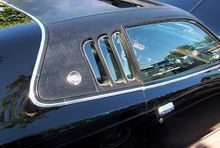 Unusual triple opera window on 1973 Dodge Charger SE
Unusual triple opera window on 1973 Dodge Charger SE
The 1973 Chargers sported all new sheet metal, though to the untrained eye, the rear roof C-pillars looked like the only difference from the 1972s. Also new were vertically slatted taillights and new grills. Hidden headlights were dropped, even as an option. The 318 was still standard, with the 340 (available only on the Rallye), 400 ( 2 and 4 bbl. ) and 440 remaining as options. The SE models had a new roof treatment that had a "triple opera window" surrounded by a canopy-style vinyl roof. All other models had a new quarter window treatment, ditching its AMC Gremlin-style window in favor of a more conventional design. Sales this year were around 108,000 units, the highest ever for the 1971-74 Charger generation. 1973 Chargers, and all Chrysler products, were equipped with 5 mph bumpers, front and rear.
The 1973 Charger has achieved some fame since its use by Michael Westen in the USA Networks series Burn Notice. The car, a black model with an air scoop and all white interior, was left to Michael by his father, and has appeared since the third episode of the first season. It was sacrificed during the fourth season finale by being blown up to keep Vaughn's men at bay, and was rebuilt in the fourth episode of the fifth season.
1974 was a virtual rerun of 1973. Minor changes included all new color choices, a softer grain pattern on interior surfaces, and a slight increase in the size of the rubber bumper tips (brought on by ever-changing federal front and rear impact regulations). The biggest news was that the 340 option was dropped and the 360 4bbl replaced the 340 as the small block performance engine. All other engine options remained the same. Several performance rear end ratios, including a 3.23 "Sure Grip" rear end were still available. A four speed transmission was still an option except with the 440 engine. Emphasis in these years turned to luxury instead of performance, hence the high sales figures for the SE model, but one could still equip a Charger with respectable performance options if so inclined and turn in decent performance figures for the day. The Charger, however, was no longer considered a performance car, and was gradually turned into personal luxury car, because all manufacturers "saw the handwriting on the wall." The muscle car era came to a close, and the 1974 Dodge Charger would be the final year.
The 1971-74 Chargers were campaigned in NASCAR, with Buddy Baker, Bobby Issac, Dave Marcis, and Richard Petty scoring several wins. Petty won 25 races with this body style bewtween 1972 and 1977 (NASCAR allowed the Chargers to run a few years longer than normal, as Chrysler did not have anything else to replace it). It is Richard Petty's self proclaimed favorite car that he ran in his career.
1975–1978
Fourth generation 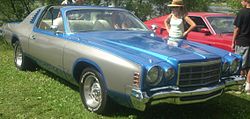
Production 1975–1978 Assembly United States: Detroit, Michigan
Hamtramck, Michigan
Los Angeles, California
St. Louis, MissouriEngine 318 cu in (5.2 L) V8
360 cu in (5.9 L) V8
400 cu in (6.6 L) V8Transmission 3-speed automatic
3-speed manual
4-speed manualWheelbase 115.0 in (2,921 mm) Length 216.0 in (5,486 mm) Height 52.0 in (1,321 mm) Related Dodge Coronet
Chrysler Cordoba
Plymouth GTX
Plymouth FuryBeginning in 1975, the Dodge Charger was based on the Chrysler Cordoba. The Charger SE (Special Edition) was the only model offered. It came with a wide variety engines from the 318 cu in (5.2 L) "LA" series small block V8 to the 400 cu in (6.6 L) big block V8. The standard engine was the 360 cu in (5.9 L) small block. Sales in 1975 amounted to 30,812. Because of the extreme squareness of the bodystyle, NASCAR teams were forced to rely on the previous years (1974) sheetmetal for race-spec cars. In order for Dodge to be represented, NASCAR allowed the 1974 sheetmetal to be used until January 1978, when the new Dodge Magnum was ready for race use. In 1976 a Dodge Charger was one of two NASCAR stock cars to compete in the 24hrs at LeMans, having been modified with head-lamps, tail-lamps and windshield wipers. It was driven by Herschel and Doug McGriff and sponsored by Olympia Beer, earning the nickname "Oly Express".
In 1976, the model range was expanded to four models; base, Charger Sport, Charger SE and the Charger Daytona. The base and Sport models used a different body than the SE and Daytona, and were essentially a rebadging of what had been the 1975 Dodge Coronet 2-door models — and available with a 225 cu in (3.7 L) Slant Six, which was not offered on the SE and Daytona. The Charger Daytona was introduced as an appearance package with either the 360 or 400 engine. Sales increased slightly to 65,900 units in 1976.
In 1977, the base Charger and Charger Sport were dropped as this body style became part of the newly named B-body Monaco line, and only the Charger SE and Charger Daytona were offered. Sales dropped to 36,204. In 1978, only about 2,800 Chargers were produced, after which it was replaced by the similar 1978 Dodge Magnum.
See also
References
- ^ a b Severson, Aaron (27 November 2007). "Dodging the Issue: The Original Dodge Charger". Ate Up With Motor. http://ateupwithmotor.com/sports-cars-and-muscle-cars/66-dodge-charger-1966-1967.html. Retrieved 10 October 2010.
- ^ Bouwkamp, Burton (1969-09-14). "Birth and death of the original Dodge Charger: Dodge's Burt Bouwkamp speaks". Allpar.com. http://www.allpar.com/cars/dodge/charger-history.html. Retrieved 2010-06-30.
- ^ a b Genat, Robert; Newhardt, David (2004). Mopar Muscle: Fifty Years. MBI Publishing. pp. 115–117. ISBN 9780760320167.
- ^ Mueller, Mike (2003). Musclecar Icons. MBI Publishing. p. 262. ISBN 9780760317730. http://books.google.com/books?id=u38tuOjjkwAC&pg=PA262&dq=1966+Dodge+Charger+ho-hum&hl=en. Retrieved 10 October 2010.
- ^ Auto Editors of Consumer Guide (16 October 2007). "1967 Dodge Charger Sales". auto.howstuffworks.com. http://auto.howstuffworks.com/1966-1967-dodge-charger11.htm. Retrieved 9 October 2010.
- ^ "Four Wheel Drift: Best and Worst Paint Colors". Fourwheeldrift.wordpress.com. 2006-09-30. http://fourwheeldrift.wordpress.com/2006/09/30/color-me-crazy-%E2%80%93-the-best-and-worst-paint-color-names/. Retrieved 2010-10-10.
External links
Dodge road car timeline, United States market, 1950s–1970s — next » Type 1950s 1960s 1970s 0 1 2 3 4 5 6 7 8 9 0 1 2 3 4 5 6 7 8 9 0 1 2 3 4 5 6 7 8 9 Subcompact Omni / 024 Colt Compact Colt Colt Colt Lancer Dart Dart Dart Aspen Mid-size Wayfarer Dart Diplomat Coronet Coronet Monaco Magnum Full-size Coronet Coronet Coronet Dart 880 / Custom 880 Royal Royal Matador 330 Monaco Monaco St. Regis Meadowbrook La Femme 440 Custom Royal Polara Polara Polara Polara Sports Charger Charger Charger Charger Challenger Challenger Super Bee Dodge Current
productionCarsTrucks (Ram)Discontinued Cars024 · 330 · 400 · 600 · 880 · Aries · Aspen · Avenger · Brisa · Challenger · Charger (B-body) · Charger (L-body) · Charger Daytona · Colt · Conquest · Coronet · Custom 880 · Dart · Daytona · Demon · Diplomat · Dynasty · Intrepid · La Femme · Lancer · Matador · Mirada · Monaco · Neon · Omni · Phoenix · Polara · SE · Shadow · Sierra · Spirit · SRT-4 · St. Regis · Stealth · Stratus · Super BeeTrucks50 Series · 100 Series · 500 Series · A100 · B Series · C Series · D Series · Power Wagon · Rampage · Ram 50 · VC series · VF series · WC seriesCorporate Category:Dodge vehicles · Chrysler LLCCategories:- Dodge vehicles
- Muscle cars
- Rear wheel drive vehicles
- Mid-size cars
- Coupes
- 1960s automobiles
- 1970s automobiles
- Vehicles introduced in 1966
Wikimedia Foundation. 2010.

